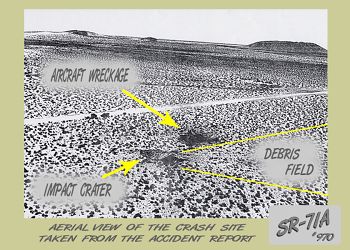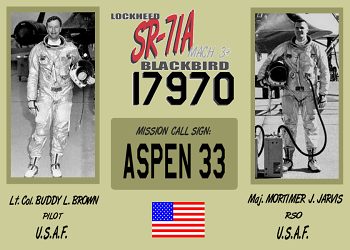
 |
Two KC-135Q tankers took off first and proceeded to the BUSY PALACE refueling track near Albuquerque, New Mexico. The first tanker used call sign OSSAL 59. The second KC-135Q (59-1474), using call sign OSSAL 73, was crewed by Maj. Carl J. Roland, Capt. Darrell F. Messenger, Maj. Neil I. Walters, and CMSgt. David C. Eckley. OSSAL 73 proceeded to a portion of the refueling track near El Paso, Texas.
Brown and Jarvis entered the cockpit of the SR-71 and prepared for takeoff. Engine start and run-up were completed without incident. Using call sign ASPEN 33, they took off from Beale AFB, California, and proceeded to BUSY PALACE.
ASPEN 33 accomplished climb, acceleration, and high-Mach cruise, followed by a descent into the BUSY PALACE refueling track. Brown hooked up with the first KC-135Q, OSSAL 59, without incident. After transferring 35,000 pounds of fuel, Brown disconnected, and maneuvered to hook up with OSSAL 73, near El Paso, Texas.
Contact with the second tanker was smooth and effective. Three minutes later, following transfer of 16,000 pounds of fuel, the SR-71 suddenly dropped four to six feet. As Brown attempted to stabilize the aircraft, it pitched up and struck the tanker.
The crew of OSSAL 73 heard and felt the collision. The boomer, CMSgt. Eckley watched in horror as the aircraft pitched upward with such rapidity that he had no time to take action or call for a breakaway. The black shape of the SR-71 briefly filled the boomer's window, the tanker shuddered with the impact, and the stricken spyplane dropped away.
The Blackbird's canopy glass fractured, causing Brown to lose all outside references. Also, his control panel had broken loose from it mounts and he was unable to control the airplane. Brown called Jarvis over the intercom to order him to eject, but Jarvis never heard him. Jarvis saw the flash as Brown bailed out, and the PILOT EJECTED light on his instrument panel. Jarvis then ejected, and both crewmembers parachuted to safety.
Eckley reported the collision to the flight crew over the tanker's intercom. Maj. Roland and Capt. Messenger checked their flight controls and determined that the KC-135 was still airworthy. They then reported the accident to Albuquerque Air Traffic Control Center and told them to initiate recovery procedures for the downed SR-71 crew.
The SR-71 impacted the ground some 20 miles east of El Paso, blasting a crater in the desert. The airplane was completely destroyed. It had logged a total of 545.3 flight hours. A helicopter from Fort Bliss arrived within minutes and picked up the crew. They were taken to Beaumont Army Hospital for examination and treatment.
The KC-135 proceeded back to Beale where it landed without major difficulties. The refueling boom, which could not be stowed after the collision, dragged the runway during landing.
 |
